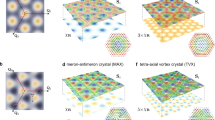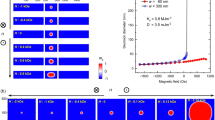Abstract
Spontaneously emergent chirality is an issue of fundamental importance across the natural sciences1. It has been argued that a unidirectional (chiral) rotation of a mechanical ratchet is forbidden in thermal equilibrium, but becomes possible in systems out of equilibrium2. Here we report our finding that a topologically nontrivial spin texture known as a skyrmion—a particle-like object in which spins point in all directions to wrap a sphere3—constitutes such a ratchet. By means of Lorentz transmission electron microscopy we show that micrometre-sized crystals of skyrmions in thin films of Cu2OSeO3 and MnSi exhibit a unidirectional rotation motion. Our numerical simulations based on a stochastic Landau–Lifshitz–Gilbert equation suggest that this rotation is driven solely by thermal fluctuations in the presence of a temperature gradient, whereas in thermal equilibrium it is forbidden by the Bohr–van Leeuwen theorem4,5. We show that the rotational flow of magnons driven by the effective magnetic field of skyrmions gives rise to the skyrmion rotation, therefore suggesting that magnons can be used to control the motion of these spin textures.
This is a preview of subscription content, access via your institution
Access options
Subscribe to this journal
Receive 12 print issues and online access
$259.00 per year
only $21.58 per issue
Buy this article
- Purchase on Springer Link
- Instant access to full article PDF
Prices may be subject to local taxes which are calculated during checkout




Similar content being viewed by others
Change history
30 January 2014
In the version of this Letter originally published online, in Fig. 4c, the solid blue curve was missing. This error has now been corrected in all versions of the Letter.
References
Gardner, M. The New Ambidextrous Universe (Freeman, (1990).
Feynman, R. P. The Feynman Lectures on Physics Vol. 1, Ch. 46 (Addison-Wesley, (1963).
Skyrme, T. H. R. A unified field theory of mesons and baryons. Nucl. Phys. 31, 556–569 (1962).
Bohr, N. Studier over Metallernes Elektrontheori (Kobenhavns Universitet, 1911).
Van Leeuwen, H. J. Problemes de la theorie electronique du magnetisme. J. Phys-Paris 2, 361–377 (1921).
Bogdanov, A. N. & Yablonskiî, D. A. ‘Thermodynamically stable vortices’ in magnetically ordered crystals: The mixed state of magnets. Sov. Phys. JETP 68, 101–103 (1989).
Bogdanov, A. & Hubert, A. Thermodynamically stable magnetic vortex states in magnetic crystals. J. Magn. Magn. Mater. 138, 255–269 (1994).
Rößler, U. K., Bogdanov, A. N. & Pfleiderer, C. Spontaneous skyrmion ground states in magnetic metals. Nature 442, 797–801 (2006).
Mühlbauer, S. et al. Skyrmion lattice in a chiral magnet. Science 323, 915–919 (2009).
Tonomura, A. et al. Real-space observation of skyrmion lattice in helimagnet MnSi thin samples. Nano Lett. 12, 1673–1677 (2012).
Pfleiderer, C. et al. Skyrmion lattices in metallic and semiconducting B20 transition metal compounds. J. Phys. Condens. Matter 22, 164207 (2010).
Münzer, A. et al. Skyrmion lattice in the doped semiconductor Fe1−xCoxSi. Phys. Rev. B 81, 041203(R) (2010).
Yu, X. Z. et al. Real-space observation of a two-dimensional skyrmion crystal. Nature 465, 901–904 (2010).
Yu, X. Z. et al. Near room-temperature formation of a skyrmion crystal in thin-films of the helimagnet FeGe. Nature Mater. 10, 106–109 (2010).
Seki, S., Yu, X. Z., Ishiwata, S. & Tokura, Y. Observation of skyrmions in a multiferroic material. Science 336, 198–201 (2012).
Adams, T. et al. Long-wavelength helimagnetic order and skyrmion lattice phase in Cu2OSeO3 . Phys. Rev. Lett. 108, 237204 (2012).
Seki, S. et al. Formation and rotation of skyrmion crystal in the chiral-lattice insulator Cu2OSeO3 . Phys. Rev. B 85, 220406 (2012).
Jonietz, F. et al. Spin transfer torques in MnSi at ultralow current densities. Science 330, 1648–1651 (2010).
Everschor, K. et al. Rotating skyrmion lattices by spin torques and field or temperature gradients. Phys. Rev. B 86, 054432 (2012).
Yu, X. Z. et al. Skyrmion flow near room temperature in an ultralow current density. Nature Commun. 3, 988 (2012).
Iwasaki, J., Mochizuki, M. & Nagaosa, N. Universal current–velocity relation of skyrmion motion in chiral magnets. Nature Commun. 4, 1463 (2013).
Yi, S. D., Onoda, S., Nagaosa, N. & Han, J. H. Skyrmions and anomalous Hall effect in a Dzyaloshinskii–Moriya spiral magnet. Phys. Rev. B 80, 054416 (2009).
Bak, P. & Jensen, M. H. Theory of helical magnetic structures and phase transitions in MnSi and FeGe. J. Phys. C 13, L881–L885 (1980).
Brown, W. F. Jr. Thermal fluctuations of a single-domain particle. Phys. Rev. 130, 1677–1686 (1963).
Kubo, R. & Hashitsume, N. Brownian motion of spins. Prog. Theor. Phys. Suppl. 46, 210–220 (1970).
García, J. L. & Lázaro, F. J. Langevin-dynamics study of the dynamical properties of small magnetic particles. Phys. Rev. B 58, 14937–14958 (1998).
Petrova, O. & Tchernyshyov, O. Spin waves in a skyrmion crystal. Phys. Rev. B 84, 214433 (2011).
Kong, L. & Zang, J. Dynamics of an insulating skyrmion under a temperature gradient. Phys. Rev. Lett. 111, 067203 (2013).
Nagaosa, N. & Tokura, Y. Emergent electromagnetism in solids. Phys. Scr. T 146, 014020 (2012).
Van Hoogdalem, K. A., Tserkovnyak, Y. & Loss, D. Magnetic texture-induced thermal Hall effects. Phys. Rev. B 87, 024402 (2013).
Kruglyak, V. V., Demokritov, S. O. & Grundler, D. Magnonics. J. Phys. D 43, 260301 (2010).
Acknowledgements
The authors thank A. Rosch, M. Ichikawa, Y. Matsui, Y. Ogimoto and E. Saito for discussions. X.Z.Y. is grateful to K. Nishizawa and T. Kikitsu for providing a transmission electron microscope (JEM2100F). This research was in part supported by JSPS KAKENHI (Grant Numbers 24224009, 24360036, 25870169 and 25287088), by the Funding Program for World-Leading Innovative R&D on Science and Technology (FIRST Program), Japan, and by G-COE Program ‘Physical Sciences Frontier’ from MEXT Japan. M. Mostovoy was supported by FOM grant 11PR2928 and the Niels Bohr International Academy. J.Z. is supported by the Theoretical Interdisciplinary Physics and Astrophysics Center and by the US Department of Energy, Office of Basic Energy Sciences, Division of Materials Sciences and Engineering under Award DEFG02-08ER46544.
Author information
Authors and Affiliations
Contributions
M. Mochizuki carried out the numerical simulations and analysed the simulation data. X.Z.Y. carried out the Lorentz TEM measurement and analysed the experimental data. S.S. carried out the crystal growth of Cu2OSeO3. N.K. carried out the crystal growth of MnSi. The whole work has been led by N.N. and Y.T. The results were discussed and interpreted by M. Mochizuki, X.Z.Y., W.K., J.Z., M. Mostovoy, Y.T. and N.N. The draft was written by M. Mochizuki, M. Mostovoy, Y.T. and N.N.
Corresponding author
Ethics declarations
Competing interests
The authors declare no competing financial interests.
Supplementary information
Supplementary Information
Supplementary Information (PDF 907 kb)
Supplementary Information
Supplementary Movie S1 (MOV 7047 kb)
Supplementary Information
Supplementary Movie S2 (MOV 4509 kb)
Supplementary Information
Supplementary Movie S3 (MOV 2666 kb)
Supplementary Information
Supplementary Movie S4 (MOV 14358 kb)
Supplementary Information
Supplementary Movie S5 (MOV 1039 kb)
Supplementary Information
Supplementary Movie S6 (MOV 2660 kb)
Rights and permissions
About this article
Cite this article
Mochizuki, M., Yu, X., Seki, S. et al. Thermally driven ratchet motion of a skyrmion microcrystal and topological magnon Hall effect. Nature Mater 13, 241–246 (2014). https://doi.org/10.1038/nmat3862
Received:
Accepted:
Published:
Issue Date:
DOI: https://doi.org/10.1038/nmat3862
This article is cited by
-
Acoustic-driven magnetic skyrmion motion
Nature Communications (2024)
-
Ordered creation and motion of skyrmions with surface acoustic wave
Nature Communications (2023)
-
Progress on elliptical magnetic skyrmions
Rare Metals (2023)
-
Lorentz electron ptychography for imaging magnetic textures beyond the diffraction limit
Nature Nanotechnology (2022)
-
Tunable Brownian magneto heat pump
Scientific Reports (2022)



